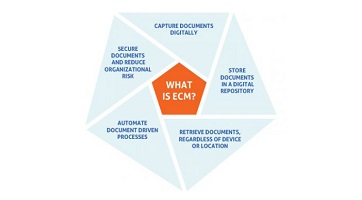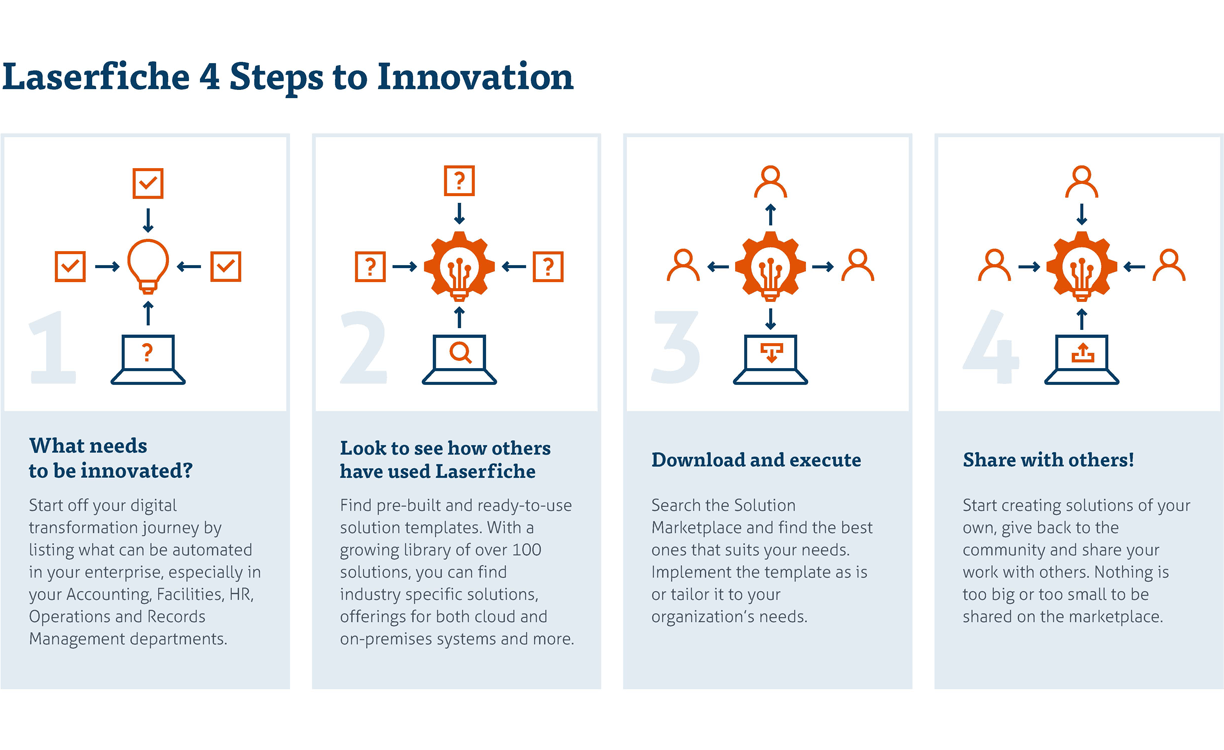What is Enterprise Content Management?
What does ECM mean and why is it important?
An Enterprise Content Management (ECM) system enables organizations to securely manage content and information throughout its lifecycle. It enables unstructured information — such as Word documents, PDFs, emails and scanned images — to be securely stored and made accessible to authorized users.
From commercial supply chains to contract management, HR processes to government administration, the driving force behind implementing an ECM solution is to do business more efficiently. By eliminating dependence on paper documents and organizing unstructured information according to business needs, organizations can simplify and streamline work.
Top 5 Elements of ECM
Listening to our customers over the years, we’ve found consistent goals for implementing ECM. Customers commonly rely on ECM to:
- Decrease dependence on paper and streamline business processes.
- Drive better customer service and increase productivity.
- Reduce organizational risk.
Leading ECM solutions, including Laserfiche, accomplish these goals and more. Here are 5 key elements of an ECM solution:

1. Capture documents digitally
Managing an organization’s content begins with the capture and importing of information into a secure digital repository. This can be any kind of document that is created, captured, stored, shared or archived, including:
- Invoices from vendors.
- Resumes from job applicants.
- Contracts.
- Correspondence.
- Research reports.
A few methods of capturing these documents include:
- Using electronic forms to make documents digital from the point of creation.
- Scanning paper documents to be filed in a digital repository.
- Managing natively digital content, including Microsoft Office documents, PDFs, photos and videos.
- Automatically filing and categorizing documents from servers, shared devices and network drives.
Traditional methods of capturing documents require a great deal of effort and expense. Capturing documents in a digital repository eliminates many of the obstacles created by paper: labor-intensive duplication, slow distribution, misplaced originals and the inconvenience of retrieving files from offsite storage.
2. Store documents in a digital repository
With robust ECM systems, organizations can easily store any business-critical document in a digital repository, allowing users to:
- Decide who can view, edit and create documents.
- Classify and search for documents based on metadata
- Organize documents within a flexible folder structure.
The benefits of enterprise content management go far beyond document storage. An ECM system also reduces the time, cost and complexity associated with managing documents that require retention schedules, throughout their life cycle, assisting in efforts to bolster regulatory compliance.
3. Retrieve documents, regardless of device or location
Once an organization’s records have been securely stored, you can:
- Find any document using full-text search.
- Identify specific words or phrases within document text, metadata, annotations and entry names.
- Use preset search options to search by document creation date, the names of users who checked out documents and other metadata.
Enterprise content management software helps eliminate time spent searching for information, enabling employees to answer information requests from clients, citizens and auditors immediately. More than that, staff have instant access to the information required to make better decisions about issues that can your organization’s bottom line.
4. Automate document-driven processes
Automation helps organizations eliminate manual tasks — such as photocopying or even drag-and-dropping digital documents — to achieve greater results with fewer resources. Some ECM systems have digital automation features that can:
- Automatically route documents to the right people at the right time.
- Alert staff members when documents require their attention.
- Recognize errors before they cause delays or make staff redo work.
Every day, businesses need purchase orders signed, records archived and employee vacation requests approved or denied. Automation moves these critical documents through the necessary steps of review and approval, in the order specified. The end result is processes that are more cost-efficient, streamlined and error-free.
5. Secure documents and reduce organizational risk
With strengthening compliance restrictions in a wide range of industries, organizations are increasingly using ECM systems to optimize records management practices and protect against risk. An enterprise content management system must provide customizable security settings to allow organizations to protect information from unauthorized access or modification. These settings should allow you to:
- Restrict access to folders, documents, fields, annotations and other granular document properties as needed.
- Monitor system login and logout, document creation and destruction, password changes and more.
- Protect sensitive metadata by controlling access to information within individual folders, templates and fields.
Leading ECM solutions enable line of business departments to manage user access independently — which means sensitive HR information stays within the HR department, while private financial information stays within the finance department, even if the information is stored in the same repository.
What are some use cases for ECM?
An ECM can assist your organization in a variety of ways. Below are a few examples:
- Accounts payable: Capture information from invoices and purchaser orders (POs), automate invoice matching and flag mismatches between invoices and POs.
- Customer and client services: Provide secure, anytime access to documents customers and clients need with online portals hosting digital documents.
- Remote and off-site work: Give those working from home or in the field the tools, content and services they need to do their jobs effectively.
- Staffing and recruiting: Streamline approvals, paperwork, and everything else involved in bringing in new talent to your organization.
- Information governance: Bolster your efforts to keep information secure and in compliance with a set of powerful records management tools.
Customer Spotlight: Learning Arts
Learn how Learning Arts, a company dedicated to the care of children with autism, leveraged ECM to share data about patients with their parents and behavior specialists in real-time to enhance care and programming.
Browse customer reviews of Laserfiche on G2
Get insights from real customers on why Laserfiche is a top choice for organizations looking to further their digital transformation with ECM.
Continue your journey
As you can see, an ECM can help streamline a wide variety of processes. Below are some resources to help you continue exploring solutions to your business challenges.
Schedule a personalized Laserfiche demo
Most ECM platforms include a few of these 5 key elements, but category leaders — like Laserfiche — provide a complete ECM solution, helping your organization dramatically improve business processes. See first hand how Laserfiche can be your solution and schedule a demo.
Discover powerful solutions on the Laserfiche Solution Marketplace
Some of the more robust ECM systems, including Laserfiche, offer marketplaces for process templates you can use to jumpstart digital transformation initiatives. To learn more about the Laserfiche Solution Marketplace, watch the video below:
Explore Laserfiche’s 4 Steps to Innovation
Also be sure to check out the below infographic “Laserfiche 4 Steps to Innovation” to see how Laserfiche users can not only deploy solutions quickly, but get involved with a larger community of innovators.
Evaluate and shop for software more effectively with our buyer’s guide
To learn more about what enterprise content management is and how it works, download the ECM Software Buyer’s guide.

Check out the G2 Grid® for Enterprise Content Management (ECM)
Comparing ECM systems? Compare the top vendors in the space with the G2 Grid® for Enterprise Content Management (ECM):

